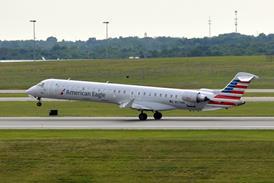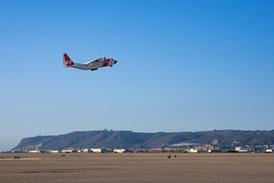GUY NORRIS / LOS ANGELES
Technical and business factors are behind favourable study results indicating conventional option for supersonic jets
Modified derivatives of conventional turbofans are emerging as the best option for potential supersonic business jets (SSBJ) now under evaluation by Dassault and Gulfstream, says Rolls-Royce. A conventional engine with a two-spool arrangement looks the most promising for speeds below Mach 2.
Describing the studies, R-R advanced programmes executive John Whurr says the preference for a conventionally based solution is based on technical and business factors. Speaking at the recent ACE conference in Seattle, Whurr said: "The SSBJ market is insufficient to justify the development of a completely new propulsion system. Rolls-Royce currently favours a conventional turbofan solution because it is the easiest development route, and it also has the lowest development cost."
R-R studied three of what it considers the "most practical" SSBJ power plant concepts: a conventional turbofan (CTF), a mixer nozzle/ejector (MNE) and a mid-tandem fan (MTF).
The CTF concept was based on a two-spool arrangement, while the MNE idea was similar to the low-bypass ejector concept studied by US engine makers and NASA for the cancelled High Speed Research (HSR) supersonic transport (SST) project.
The MTF, described by Whurr as "really just a mid-fan", was arranged with the fan bypass section behind the low pressure compressor, rather than its more conventional position ahead of the compressor. The MTF was one of four variable cycle engine concepts studied jointly by R-R and Snecma in the mid-1990s in support of European second-generation SST studies.
Based on its initial analysis, R-R says the overall performance of the MNE concept comes out on top for configurations aimed at cruise speeds above M2.4, particularly for larger supersonic aircraft. The MTF appears to be optimum for M2 cruise conditions, "but the real downside of the MTF is complexity," adds Whurr. "In many ways the ejector design is a winner, but at M2 and below, a conventional, low-risk approach is just as good."
As a result, the CTF appears optimum for designs aimed at supersonic cruise speeds below M2, which is the range favoured by Dassault and Gulfstream.
To boost the performance of the CTF, R-R is starting a series of advanced concept studies. One of the most unusual is a bladed spinner fan which consists of a series of part-height blades located ahead of the main rotor (see diagram). Computational fluid dynamic tests of the arrangement show the potential to increase flow capacity by as much as 7% without any increase in fan diameter.
The mini-blades reduce the effective hub/tip ratio and increase the fan/hub pressure ratio. R-R says that further tests, including the potential effect of the bladed spinner on fan noise signature, are planned. The company remains mindful, it says, of the unusual noise signature of General Electric's pioneering TF39, which has a conceptually similar half-stage front fan.
The bladed spinner fan would be married to a version of the advanced swept fan currently under test by R-R for the Trent family. Other advanced studies include a host of new low pressure and core technologies, a new low pressure turbine design and "Concorde-style" nozzles.
Source: Flight International























